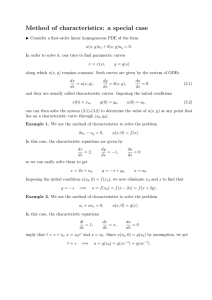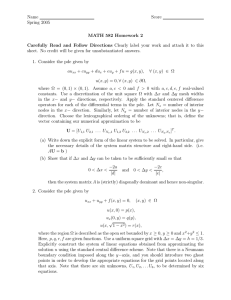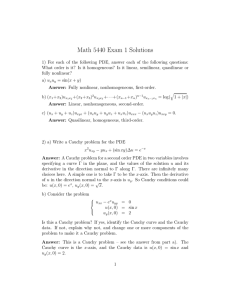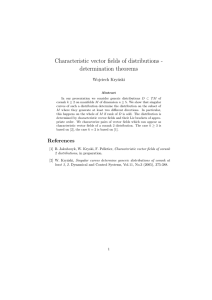First Order Partial Differential Equations 1
advertisement
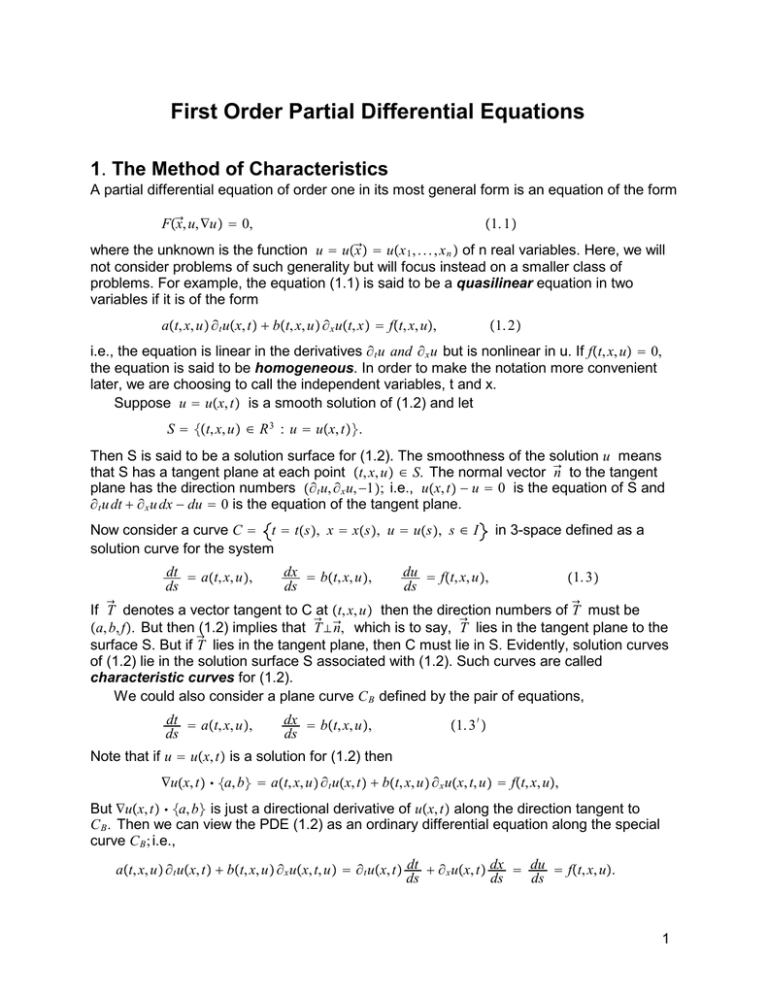
First Order Partial Differential Equations 1. The Method of Characteristics A partial differential equation of order one in its most general form is an equation of the form Fx⃗, u, ∇u = 0, 1. 1 where the unknown is the function u = ux⃗ = ux 1 , . . . , x n of n real variables. Here, we will not consider problems of such generality but will focus instead on a smaller class of problems. For example, the equation (1.1) is said to be a quasilinear equation in two variables if it is of the form at, x, u ∂ t ux, t + bt, x, u ∂ x ut, x = ft, x, u, 1. 2 i.e., the equation is linear in the derivatives ∂ t u and ∂ x u but is nonlinear in u. If ft, x, u = 0, the equation is said to be homogeneous. In order to make the notation more convenient later, we are choosing to call the independent variables, t and x. Suppose u = ux, t is a smooth solution of (1.2) and let S = t, x, u ∈ R 3 : u = ux, t. Then S is said to be a solution surface for (1.2). The smoothness of the solution u means that S has a tangent plane at each point t, x, u ∈ S. The normal vector ⃗ n to the tangent plane has the direction numbers ∂ t u, ∂ x u, −1; i.e., ux, t − u = 0 is the equation of S and ∂ t u dt + ∂ x u dx − du = 0 is the equation of the tangent plane. Now consider a curve C = t = ts, x = xs, u = us, s ∈ I solution curve for the system dt = at, x, u, ds dx = bt, x, u, ds in 3-space defined as a du = ft, x, u, ds 1. 3 ⃗ denotes a vector tangent to C at t, x, u then the direction numbers of T ⃗ must be If T ⃗⃗ ⃗ lies in the tangent plane to the n, which is to say, T a, b, f. But then (1.2) implies that T ⃗ surface S. But if T lies in the tangent plane, then C must lie in S. Evidently, solution curves of (1.2) lie in the solution surface S associated with (1.2). Such curves are called characteristic curves for (1.2). We could also consider a plane curve C B defined by the pair of equations, dt = at, x, u, ds dx = bt, x, u, ds 1. 3 ′ Note that if u = ux, t is a solution for (1.2) then ∇ux, t ⋅ a, b = at, x, u ∂ t ux, t + bt, x, u ∂ x ux, t, u = ft, x, u, But ∇ux, t ⋅ a, b is just a directional derivative of ux, t along the direction tangent to C B . Then we can view the PDE (1.2) as an ordinary differential equation along the special curve C B ; i.e., at, x, u ∂ t ux, t + bt, x, u ∂ x ux, t, u = ∂ t ux, t dt + ∂ x ux, t dx = du = ft, x, u. ds ds ds 1 We refer to the curves C as "space characteristics" and to the plane curves C B as "base characteristics" for the PDE (1.2). In general, the PDE is solved by solving the ordinary differential equations (1.3) for C as a system. In certain special cases, the solution process can be accomplished by solving the pair of equations (1.3’) first and then solving the ODE for u separately. We will recall now some notions from differential geometry that will clarify the procedure for solving the system (1.3). Integral Curves for Vector Fields ⃗ = Pt, x, u, Qt, x, u, Rt, x, u is called a vector field if P,Q,R A vector valued function, V are all smooth functions and if P 2 + Q 2 + R 2 is never zero. A space curve, ⃗ C = t = ts, x = xs, u = us, s ∈ I is said to be an integral curve or trajectory for V ⃗ is tangent to C at every point; i.e., if if V dt = Pt, x, u, ds or, equivalently, dx = Qt, x, u, ds dt = dx = du P R Q du = Rt, x, u, ds 1. 4a 1. 4b ⃗ = P, Q, R if A function φ = φt, x, u is said to be a first integral for the vector field V Pt, x, u ∂ t φ + Qt, x, u ∂ x φ + Rt, x, u ∂ u φ = 0. 1. 5 ⃗ will be found by representing C as the intersection of level The trajectories C for V surfaces of first integrals. The level surfaces S j = t, x, u : φ j t, x, u = C j j = 1, 2 intersect transversally at each point if their normals, ⃗ n 1 and ⃗ n 2 are never parallel. This situation occurs if φ 1 and φ 2 are such that the expression ∇φ 1 × ∇φ 2 is different from zero at each point. In this case the functions φ 1 and φ 2 are said to be functionally independent and their level surfaces S 1 and S 2 intersect in a curve C. Since C then lies in both of the surfaces, S 1 and S 2 , the tangent to C is normal to both ⃗ n 1 and ⃗ n 2 , that is to both ∇φ 1 and ∇φ 2 . This is the same thing as saying both φ 1 and φ 2 satisfy (1.5). We will illustrate with examples. Example 1.1 ⃗ = t, x, u. A first integral must satisfy 1. Consider the radial vector field V t ∂ t φt, x, u + x ∂ x φt, x, u + u ∂ u φt, x, u = 0. To obtain a solution, we consider the following system of ode’s dt = dx = du dt = dx dx = du or and x u x x u t t dt = dx leads to x = C 1 , Then x t t dx = du implies x = C 2 . and x u u x ⃗ = t, x, u. We That is, φ 1 t, x, u = and φ 2 t, x, u = ux are a pair of first integrals for V t can show that for any smooth function F of two variables, φ 3 t, x, u = Fφ 1 t, x, u, φ 2 t, x, u 2 ⃗ and φ 3 is then viewed as an implicit representation for the most is also a first integral for V general solution of the first integral pde. ⃗ then Problem 1.1 Show that if φ 1 t, x, u and φ 2 t, x, u are a pair of first integrals for V φ 3 t, x, u = Fφ 1 t, x, u, φ 2 t, x, u, where F denotes an arbitrary smooth function of two ⃗. variables, is also a first integral for V . Problem 1.2 Show that φ 1 t, x, u = x and φ 2 t, x, u = ux are functionally independent. t ⃗ = t, u, x. The trajectories are solution curves for the 2. Consider the vector field V following system of ode’s From dt = dx = du dt = du dx = du or and u x x x u t t dx = du it follows that x 2 = u 2 + C 1 . Then u x dt = du = du and t = C 2 u + u 2 + C 1 = C 2 u + x. x t 2 u + C1 Evidently, φ 1 = x 2 − u 2 and φ 2 = u +t x are a pair of first integrals for the vector field ⃗ = t, u, x. Each of these functions satisfies V t ∂ t φt, x, u + u ∂ x φt, x, u + x ∂ u φt, x, u = 0, and the most general solution of this equation can be written implicitly as F x 2 − u 2 , u +t x = 0, where F denotes an arbitrary smooth function of two variables. Characteristics for Quasilinear PDE’s of Order 1 We are aware now that C is a characteristic curve for the quasilinear pde (1.2) if C is a ⃗ = a, b, −f. Then solutions for the pde can be obtained from trajectory for the vector field V first integrals for the vector field. However, we are not usually interested in finding the most general solution for the pde but are instead interested in finding certain particular solutions. For example, we shall be interested in finding a solution for (1.2) that satisfies the additional condition that ux, t = gx, t on C I : x = xτ, t = tτ. where the curve C I and the function g are given. A condition of this form is called a Cauchy condition, and the problem of finding a solution for (1.2) that satisfies the Cauchy condition is called a Cauchy initial value problem. Example 1.2 1.For λ =constant, consider the following Cauchy problem ∂ t ux, t + λ ∂ x ux, t = 0, ux, 0 = 1 . 1 + x2 3 The characteristic system (1.3) becomes, x ′ s = λ, t ′ s = 1, u ′ s = 0 dx = λ. This pair of The base characteristics, C B are solution curves for, dt = 1, ds ds equations is equivalent to the single equation, dx = λ, for which the solution is, dt xt = λt + x 0 . The base characteristic curves, C B , are a family of straight lines all having the same slope. Then along any base characteristic curve, ∂ t ux, t + λ ∂ x ux, t = ∂ t ux, t + ∂ x ux, t dx = du = 0, dt dt from which it follows that u is a constant on each such curve. To express the fact that u is constant along base characteristics but need not equal the same constant on every base characteristic, we can write, ux, t = fx − λt where f = fz denotes an arbitrary smooth function of one variable. Then ux, t = fx − λt is a general solution for the partial differential equation. Now ux, 0 = fx and this, combined with the Cauchy initial condition, leads to the particular solution ux, t = 1 1 + x − λt 2 for the Cauchy problem. Note that the initial value u 0 = ux 0 , 0 of the solution at the point x 0 propagates along the line x − λt = x 0 ; i. e. , ux, t = u 0 at all points x, t such that x − λt = x 0 . As a result, if the initial data is specified only on the interval, say 0 < x < 10, then the solution is determined only in the strip, Σ = x, t : λt < x < λt + 10, t > 0. The strip Σ is the domain of influence of the initial interval I = 0 < x < 10. The pde in this example is linear which leads to the result that the characteristic system of ode’s uncouples. That is, the first two equations are independent of u which means we can solve the equation x ′ t = λ separately from the equation u ′ t = 0. 2. Now consider a Cauchy problem for the variable coefficient equation ∂ t ux, t + t ∂ x ux, t = 0, ux, 0 = 1 . 1 + x2 Here we replaced the constant coefficient with the variable coefficient, λt = t. The coefficients in this equation are functions of the independent variables, x, t but do not depend on the unknown function u. Hence the equation is a linear partial differential equation as was the equation in the previous example. The base characteristics are solution curves for the system t ′ s = 1, and x ′ s = t. This is equivalent to the single ode, dx = t whose solution is given by, dt x = t 2 /2 + c 0 , or x − t 2 /2 = c 1 . Then the base characteristics in this problem are a family of parabolas. The remaining equation in the characteristic system, u ′ s = 0, implies that u is constant along the base characteristic curves. Since u need not have the same constant value on every base characteristic, the general solution has the form ux, t = Fx − t 2 /2 for an arbitrary smooth function of one variable F. Using this in the initial condition leads to, ux, 0 = Fx = 1 . 1 + x2 and then the particular solution that solves the initial value problem is given by, 4 ux, t = 1 . 2 1 + x − t 2 /2 3. Finally, consider a Cauchy problem for an inhomogeneous equation ∂ t ux, t + t ∂ x ux, t = 4u, ux, 0 = 1 . 1 + x2 Since the left side of this equation is the same as the previous example, this problem will have the same base characteristics, x − t 2 /2 = c 1 . The third equation in the characteristic system reads u ′ t = 4u, and the solution is given by ut = C 2 e 4t along each characteristic. Since the parameter C 2 is constant on each base characteristic, but not necessarily the same constant on all base characteristics, we write ux, t = Fx − t 2 /2e 4t for the general solution of the PDE. The particular solution to the initial value problem is easily found to be ux, t = e 4t . 1 + x − t 2 /2 2 Points worth noting about these examples: ′ ′ ● the solution curves of the system t s = ax, t and x s = bx, t can be uncoupled ′ from the equation u s = fx, t, u and we can solve for x = xs, t = ts without solving for u. The solution curves are curves in the x-t plane. In order to distinguish these plane curves from the characteristic curves in 3-space, we refer to the plane solution curves as base characteristics and use the term space characteristics when referring to characteristic curves in 3-space. The base characteristics are the projections into the x-t plane of the characteristic curves for the pde’s. Since the pde’s in these examples are linear, (i.e.,the coefficients a and b do not depend on u, the base characteristics can be determined without finding u. ● the constant coefficients in example 1 led to straight line base characteristics while the variable coefficient in example 2 led to base characteristics which were parabolas. However even when the base characteristics are curved, the family of curves is coherent; i.e., base characteristics which originate at distinct points can never cross.(see the remark below) ● the space characteristic curves in the first two examples are curves of the form x = xt, u = const ; i.e., they are plane curves lying in planes parallel to the x-t plane. This is due to the fact that in both examples, the partial differential equation is homogeneous and in such cases, the pde reduces to du/dt = 0 along base characteristics with the obvious result that solutions are constant along base characteristics and along space characteristics. In example 3, the inhomogeneous pde leads to space characteristics that are not plane curves since in this case du/dt was not equal to zero. To see why characteristics for linear equations are coherent, let C 1 and C 2 denote distinct base characteristics of the equation at, x ∂ t ux, t + bt, x ∂ x ut, x, u = ft, x, u, which cross at some point x 0 , t 0 . Intersection at a point requires that the curves have noncoincident tangents at the point of intersection. But this is inconsistent with (1.2) which 5 implies that dt dx C1 = ax 0 , t 0 = bx 0 , t 0 dt dx C2 i.e., the tangents to C 1 and C 2 have equal slopes at the point of intersection. In the case of quasilinear equations, where the coefficients can depend on u, we will see that this coherence can fail. 4. Consider a Cauchy problem for a linear but inhomogeneous equation x ∂ t ux, t − 2xt ∂ x ux, t = 2t u, ux, 0 = x 3 . The characteristics are the solutions of dt = x, ds dx = −2xt, ds du = 2t u, ds dt = − dx , x 2xt or and du = − dx . 2tu 2xt Since the equation is linear, the base characteristic curves can be obtained independent of the solution u. The solutions for the characteristic equations are given by x + t2 = C0 x u = C1. and Since the parameter C 1 is constant on any base characteristic but may have distinct values on different characteristics, the general solution for the partial differential equation can be expressed as Then Fx + t 2 u = Cx1 = . x Fx ux, 0 = x = x 3 . implies that Fx = x 4 hence the particular solution for the initial value problem is, 4 ux, t = x + t 2 . x In each of these linear examples, the solution procedure was the same: first find the base characteristics and then find the solution of the partial differential equation. Note that in each case, the solution obtained was a global solution in the sense that it exists and satisfies the pde for all t ≥ 0. We shall see that in quasilinear problems, the solution may not be global in t. 4. Consider the following quasilinear problem, ∂ t ux, t + λ ∂ x ux, t = ux, t 2 , ux, 0 = 1 . 1 + x2 The characteristic system can be written as dt = dx = du λ 1 u2 or dt = dx and dt = du . λ 1 1 u2 The pde is linear in the leading terms (in fact, this special subclass of quasilinear problems is referred to as the class of semilinear problems) so that the characteristic system uncouples and the base characteristics can be found without knowing the solution u. Clearly 6 the base characteristics are the family of straight lines x − λt = x 0 . The remaining characteristic equation u ′ t = ut 2 has the solution ut = C 1 − t −1 , where C 1 is constant along the base characteristics. Since C 1 need not be the same for all base characteristics, it follows that the most general solution for the pde can be written as, ux, t = 1 . Fx − λt − t The initial condition implies ux, 0 = of the Cauchy initial value problem is ux, t = 1 = 1 , or Fx = 1 + x 2 . Then the solution Fx 1 + x2 1 x − λt 2 + 1 − t Note that in spite of the smoothness of the initial data, the solution develops a singularity at x = λ, t = 1. Plotting solution profiles at times approaching t = 1 shows that the solution behaves like a wave that propagates from left to right and sharpens to a spike at x = λ, as t approaches t = 1. u(x,t) versus x for t = 0, . 5, . 9 We compute ∂ x ux, t = −2x − 4t 1 − t + x − 4t 2 2 from which it is evident that the gradient, ∂ x ux, t has an even stronger singularity at x = 4, t = 1. The developing gradient singularity can be seen in the following plot of gradient profiles for increasing t. gradient ux, t versus x for t=0,.5,.9 7 Since this pde is semilinear (i.e., linear in its leading terms) and has smooth initial data, the spontaneous singular behavior in the solution must be due to the nonlinear term on the right side of the equation. Note also that semilinear equations permit the base characteristics (i.e. the solution curves for t ′ s = a, x ′ s = b ) to be found independent of the solution u = ux, t and then the PDE reduces to a nonlinear ODE along the base characteristics. 5. Consider the quasilinear Cauchy problem, ∂ t ux, t + u ∂ x ux, t = 0, ux, 0 = 1 = fx. 1 + x2 Here the coefficients of ∂ t ux, t and ∂ x ux, t depend on u so the characteristic equations become dt = 1, ds dx = u ds and du = 0, ds or dx = u dt and du = 0. dt In this case these equations do not uncouple. In order to solve the equations as a system, we note first the equation u ′ t = 0. This implies u = C 1 along solutions of the other equation, dx/dt = u. This is to say, u = u 0 along base characteristics which are the straight lines, x − u 0 t = x 0 . Then, as usual, we have a general solution of the form ux, t = Fx − ut. It follows from the initial condition that the initial value u 0 originating at x 0 , 0 is given by ux 0 , 0 = Fx 0 = fx 0 . The solution u can then be expressed implicitly by writing ux, t = 1 1 + x − ut 2 and this equation can be solved for u in terms of x and t. The result, obtainable using Maple or Mathematica, is a complicated function of x, t. As in the previous example, the quasilinearity of the pde produces some singular behavior in the solution. For instance, suppose and u = u 0 = fx 0 along x − u0 t = x0 u = u 1 = fx 1 along x − u1 t = x1 ≠ x0. If u 1 ≠ u 0 , then the two straight lines intersect at x ∗ , t ∗ where x0 u1x0 − u0x1 . t ∗ = − ux 11 − − u0 , x∗ = u1 − u0 Note that the time of intersection, t ∗ , is positive if x 1 > x 0 and u 1 < u 0 . At such a point of intersection, ux ∗ , t ∗ has the impossible requirement of being simultaneously equal to the distinct values u 1 ≠ u 0 . We conclude that the solution breaks down in some way at this point. Note further that ux, t = fx − ut leads to ∂ x ux, t = f ′ x − ut1 − t ∂ x ux, t; i.e. ∂ x ux, t = f ′ x − ut . 1 − t f ′ x − ut Evidently the gradient ∂ x ux, t becomes undefined at any point where, 1 − t f ′ x − ut = 0, another indication that the solution breaks down at some finite time. 8 In each of the last two examples we have seen equations with smooth coefficients and initial data develop spontaneous singularities due to the nonlinearity of the equations. The solutions in these two examples break down at some finite time and no classical solution for the initial value problems exists past this point of breakdown. It will be necessary to weaken the notion of solution in order for these nonlinear problems to be solvable globally. Finally, consider following inhomogeneous example. 6. Consider the inhomogeneous quasilinear Cauchy problem, ∂ t ux, t + u ∂ x ux, t = 1, ux, 0 = x. Here the characteristic equations become dx = u and ds dx = u so we can rewrite these as du dt = 1, ds du = 1, ds du = 1. and dt Then we arrive at first integrals, φ 1 , φ 2 φ 1 x, t, u = u − t = C 1 φ 2 x, t, u = x − and 1 2 u2 = C2 which leads to x= 1 2 = u2 + C2 = 1 2 t 2 1 2 C 1 + t 2 + C 2 + C1t + C3 and then a third integral of the system is φ 3 x, t, u = x − 1 2 t 2 − tu − t = C 3 Then a general solution can be written as, φ 1 x, t, u = Fφ 3 x, t, u; i.e., u−t = F x− 1 2 t 2 − tu − t The initial condition, x = ux, 0 − 0 = Fx − 0 leads to the particular solution, u−t = x− 1 2 t 2 − tu − t which can be solved explicitly for u as follows ux, t = x + t + 12 t 2 1+t Note that the inhomogeneous equation led to a simpler solution than the homogeneous problem in the previous example. In addition, this solution has no singularity for t > 0. Problem 1.3 Consider the Cauchy initial value problem 9 1 . 1 + x2 Solve the characteristic equations and find the equation of the base characteristic that passes through the point 1, 2. Find the most general solution of the pde. Find the particular solution that satisfies the initial condition and describe the set of points x, t where the solution is determined if the initial values are specified only for −1 < x < 1. ∂ t ux, t + x ∂ x ux, t = xt ux, t, ● ● ● ux, 0 = Problem 1.4 Consider the Cauchy initial value problem ● ● ● ● −4x ∂ t ux, t + 9t ∂ x ux, t = xt ux, 0 = x 2 u , Solve the characteristic equations to find two first integrals of the associated vector field. Find the most general solution of the pde Find the particular solution that satisfies the initial condition. Does the solution have any singular behavior? Problem 1.5 Consider the Cauchy initial value problem u ∂ t ux, t + x ∂ x ux, t = t , ● ● ● ● u1, t = 2t Solve the characteristic equations to find two first integrals of the associated vector field. Find the most general solution of the pde. Find the particular solution that satisfies the initial condition. Does the solution have any singular behavior? 10
